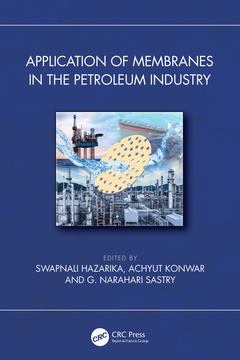Application of Membranes in the Petroleum Industry
Coordonnateurs : Hazarika Swapnali, Konwar Achyut, Sastry G. Narahari

This book focuses on the advantageous features of membrane technology in petroleum industries, with an emphasis on membrane materials and the application of membranes in the separation of olefin?paraffin, oil?water, aliphatic?aromatics, heavy metals, etc., along with other applications like waste management, sulphur emission, enhanced oil recovery, and so forth. It also discusses the design and development of membranes from novel materials, the challenges of new materials for membrane applications, membrane-based processes, and the application of novel membrane-based processes in the petroleum industry.
Features:
? Addresses the fundamental applications of membranes in petroleum industrial separation processes.
? Highlights the role of membrane technology in waste management in petroleum industries.
? Includes novel engineered membrane materials.
? Discusses methods of extracting valuable substances from produced water and membrane fouling control.
? Emphasises solving industrial problems pertinent to membrane usage.
This book is aimed at researchers and graduate students in chemical and petroleum engineering and membrane technology.
Chapter 1. An overview of membrane technology. Chapter 2. Novel membrane materials. Chapter 3. Membranes for natural gas processing. Chapter 4. Membrane for separation of olefin/paraffin. Chapter 5. Membrane-based separation of aromatics/aliphatic compounds. Chapter 6. Produced water characteristics in petroleum industries. Chapter 7. Produced Water Management. Chapter 8. Advancement of membrane technology for the separation of oil from oily wastewater in petroleum industry. Chapter 9. Membranes for removal of phenolic compounds from petroleum industry wastewater. Chapter 10. Removal of heavy metals from petroleum industry wastewater/sludge using membrane technology. Chapter 11. Enhanced Oil recovery. Chapter 12. Petroleum industry sulfur emission and removal using membrane technology. Chapter 13. Application of membrane technology in oil and gas fields. Chapter 14. Computational work on Designing of Membrane Materials useful for Petroleum Industry. Chapter 15. Future perspective of membrane technology in Petroleum Industry
Swapnali Hazarika is a dedicated researcher in the field of separation science & technology, design of adsorbent, design of customized membrane, membrane separation study including chiral separations, biomolecule separations, gas separations, wastewater treatment etc. Her study also includes membrane-based isolation and purifications of natural products, biochemical reaction engineering and mechanism, kinetic analysis of reaction diffusion, modeling and simulation, QSAR-QSPR study etc.
Achyut Konwar is a post-doctoral researcher in the Centre for Petroleum Research, CSIR – North East Institute of Science and Technology (NEIST). He received a MSc degree in Chemistry and MTech in Polymer Science and Technology. Dr Konwar has received his PhD degree in Chemistry. He is a passionate researcher in the field of polymeric hybrid materials. His research includes development of polymeric composites for different applications like packaging, membrane design, environmental remediation, biomedical, electronic etc.
G Narahari Sastry is currently working as the Director of CSIR-North East Institute of Science and Technology, Jorhat. Prof. Sastry is a chemist, working in the interdisciplinary areas spanning chemistry, biology, modeling and informatics. Dr. Sastry has been effective in employing computational and theoretical methods to solve a problem in chemistry, biology and allied areas. These efforts are embedded not only to provide a robust platform for carrying out research in CADD but also to inculcate the culture of developing software packages.
Date de parution : 07-2024
15.6x23.4 cm
Thèmes d’Application of Membranes in the Petroleum Industry :
- Économies et politiques économiques mondiales : relations économiques internationales / douanes, exportation
- Génie civil - bâtiment - travaux publics
- Génie chimique - techniques industrielles - génie des procédés
- Géographie
- Énergie
- ouvrages généraux en biologie techniques de laboratoire
- énergie, ouvrages généraux, études économiques



